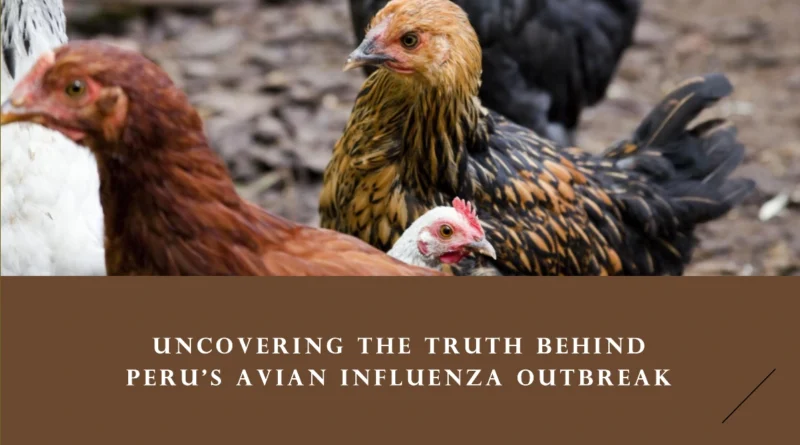Avian Influenza Outbreak in Peru: A Closer Look at the 2023 Crisis
Introduction
The year 2023 brought an unwelcome visitor to Peru: an avian influenza outbreak. Often referred to as bird flu, avian influenza is a highly contagious viral infection that primarily affects birds but can have implications far beyond the avian population. This blog delves into the 2023 avian influenza outbreak in Peru, exploring its impact on birds, wildlife, and even humans. We’ll also investigate the concerning mutations in the virus and discuss the global context of this outbreak.
Understanding Avian Influenza
What is Avian Influenza?
Avian influenza, commonly known as bird flu, is a viral disease that primarily affects birds, both domestic and wild. The virus belongs to the influenza A family, and several strains exist. While some avian influenza strains cause mild illnesses in birds, others are highly pathogenic, leading to severe disease and high mortality rates. One such highly pathogenic strain is H5N1.
| Strain | Pathogenicity | Affected Species |
| H5N1 | Highly | Birds, Humans |
| H7N9 | Highly | Birds, Humans |
| H9N2 | Low to Mild | Birds, Humans, Pigs |
| H1N1 | Low to Mild | Birds, Humans, Pigs |
| H5N8 | Highly | Birds |
How Does it Spread?
Bird flu spreads primarily through direct contact with infected birds or their feces. It can also spread indirectly through contaminated feed, water, equipment, or clothing. Wild birds, particularly waterfowl, are natural reservoirs for avian influenza viruses and can carry them over long distances during migrations.
The Avian Influenza Outbreak in Peru
Reports and Warnings
In 2023, Peru faced a severe avian influenza outbreak that had devastating consequences for both wildlife and poultry. Reports and warnings from various sources highlighted the alarming spread of the virus among bird populations. One concerning aspect of this outbreak was the identification of viral mutations, raising concerns about its potential threat to humans.
| Aspect | Data |
| Initial Outbreak Date | April 2023 |
| Confirmed Cases (Birds) | Over 100,000 |
| Confirmed Cases (Humans) | None reported |
| Poultry Losses | Estimated at 10% of poultry farms |
| Wild Bird Impact | Severe impact on coastal birds |
Impact on Poultry
Avian influenza doesn’t discriminate between domestic and wild birds. The outbreak in Peru has been confirmed in poultry farms, leading to economic losses and concerns about food security. This impact on the poultry industry can have ripple effects on the nation’s economy.
Mutations in the Virus
Concerns and Implications
The identification of mutations in the avian influenza virus is a cause for concern. Viral mutations can alter the virus’s properties, potentially making it more transmissible or virulent. This raises alarms about its potential threat to humans, as it could lead to a new strain of influenza with pandemic potential.
Avian Influenza on a Global Scale
South American Impact
Peru is not the only South American country affected by avian influenza in 2023. The virus’s reach extends across the continent, affecting bird populations in multiple nations. This regional impact underscores the need for a coordinated response.
Worldwide Bird Deaths
Beyond South America, avian influenza has caused the deaths of millions of birds globally. Reports suggest that the outbreak has been particularly devastating for bird populations. The implications of this widespread bird mortality on ecosystems and biodiversity are significant.
The Response and Prevention
| Region | Affected Countries | Bird Mortality | Economic Impact |
| South America | Peru, Brazil, Chile, etc. | Severe | Losses in poultry industry |
| North America | USA, Canada, Mexico | Moderate to Severe | Economic losses in poultry |
| Europe | Multiple countries | Moderate to Severe | Economic and ecological impact |
| Asia | China, India, Vietnam | Severe | Economic losses in poultry |
| Africa | Egypt, Nigeria, etc. | Moderate to Severe | Economic and food security |
International Cooperation
Addressing an avian influenza outbreak requires international cooperation. Countries affected by the virus must work together to share information, resources, and best practices. The World Health Organization (WHO) plays a crucial role in monitoring and responding to these outbreaks.
Preventive Measures
Preventing the further spread of avian influenza involves strict biosecurity measures in poultry farms and wild bird habitats. Quarantine measures, culling of infected birds, and public awareness campaigns are essential components of preventive strategies.
Conclusion
The avian influenza outbreak in Peru in 2023 serves as a stark reminder of the ongoing threat posed by infectious diseases. It highlights the interconnectedness of ecosystems and economies and the importance of international collaboration in addressing such crises. While the situation is concerning, ongoing research and vigilance are key to managing and preventing the further spread of avian influenza. It is a battle that requires the efforts of nations, scientists, and communities to protect both wildlife and human health.




